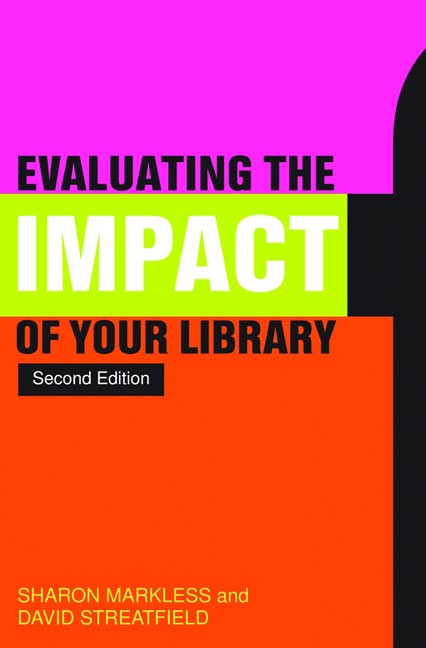Book contents
- Frontmatter
- Dedication
- Contents
- Introduction
- About the authors
- Impact and all that: use of some key terms in this book
- Part 1 The Context
- Part 2 Evaluating Impact
- 4 Putting the impact into planning
- 5 Getting things clear: objectives
- 6 Success criteria and impact indicators: how you know you are making a difference
- 7 Making things happen: activities and process indicators
- 8 Thinking about evidence
- 9 Gathering and interpreting evidence
- 10 Taking stock, setting targets and development planning
- Part 3 The Bigger Picture
- References
- Notes
- Index
- Evaluating and Measuring the Value, Use and Impact of Digital Collections
- Measuring Library Performance
- Miscellaneous Endmatter
4 - Putting the impact into planning
from Part 2 - Evaluating Impact
Published online by Cambridge University Press: 08 June 2018
- Frontmatter
- Dedication
- Contents
- Introduction
- About the authors
- Impact and all that: use of some key terms in this book
- Part 1 The Context
- Part 2 Evaluating Impact
- 4 Putting the impact into planning
- 5 Getting things clear: objectives
- 6 Success criteria and impact indicators: how you know you are making a difference
- 7 Making things happen: activities and process indicators
- 8 Thinking about evidence
- 9 Gathering and interpreting evidence
- 10 Taking stock, setting targets and development planning
- Part 3 The Bigger Picture
- References
- Notes
- Index
- Evaluating and Measuring the Value, Use and Impact of Digital Collections
- Measuring Library Performance
- Miscellaneous Endmatter
Summary
This chapter introduces the model for evaluating impact and makes some points about how to use it. You are then invited to start using the model by thinking about the answers to some general questions. Answering these questions is an important step to take in moving into the impact evaluation model.
Why do we need a new evaluation model?
The balance between service delivery, detailed consideration of processes and impact evaluation is critical when assessing the success of a service. However, our experience suggests that the balance is usually heavily weighted away from impact evaluation. Ever since we first began to work systematically with library and information service managers on impact, two points have been apparent:
The concepts and terminology get in the way. People easily become confused about such ideas as efficiency and effectiveness when they try to apply them in practice. Not only that but the terms used, such as inputs, processes, outputs and outcomes (and higher order outcomes) are applied inconsistently, both by managers in practice and in some of the published literature on performance evaluation.
When people identify an area for attention or improvement they can usually come up with a list of things to do to put it right. Generally speaking, however, people find it much harder to think about the aims and objectives underlying what they are trying to do (that is, what they are trying to achieve by providing services). Unfortunately, this focus on aims is necessary: we need to be very clear about what we are trying to achieve if we want to be able to tell whether we have succeeded. Since people are usually more comfortable with organizing and running activities, their focus on impact often gets fuzzy – when this happens we slide off into identifying process performance indicators (or ‘tick off when done’ indicators). These tell us whether things on the list have been done, but they don't tell us whether they were worth doing, or indeed whether they have had any effect.
Our response to these two challenges is to offer a process for people to work through to help to get to grips with impact. We have used this general approach with more than a thousand library and information service managers and have adapted it for all kinds of settings – from school libraries to universities and from public libraries to business and industry.
- Type
- Chapter
- Information
- Evaluating the Impact of Your Library , pp. 61 - 68Publisher: FacetPrint publication year: 2012



